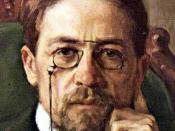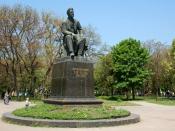In "The Lady with the Dog," Anton Chekhov uses seasonal change to help shape his narrative through scenes of fall and sunset representing when everything is beginning to settle down. This represents the impulsively maturing people in the world that are hoping for basically nothing and are unsure what they want out of life. The protagonist of this short story learns late in life that love involves a responsibility to the beloved and difficult choices must be made in order to live up to that responsibility. On first glance, Chekhov's "The Lady with the Dog" illustrates a simple plot concerning a romantic love affair. However, Chekhov cleverly paints a detailed portrait of the protagonist, Gurov, and his experience of having a love affair with Anna Sergeyevna. The subtle details woven into the plot enable the reader to decipher the motivations of Gurov's actions as well as Gurov's ultimate, internal transformation which occurs as a result of falling in love with Anna.
These details serve to exemplify Chekhov's mastery of producing an array of interpretations on "The Lady with the Dog."
Chekhov gives a philosophical perspective to love by viewing how the protagonist, Gurov, decides to lead his life. Gurov has relied on gaining pleasure through lust rather than love. His marriage lacked love and was more of convenience arranged for him by his parents, by a conventional society. The need to have affairs gave Gurov an exciting purpose to his conventional lifestyle. By feeling that he had gained yet another woman, another conquest, Gurov's appetite for living was temporarily quenched. Gurov seems addicted to this lifestyle as it is the only way he can truly feel that he has expressed his real self. This is shown by the fact that "when he was among...


